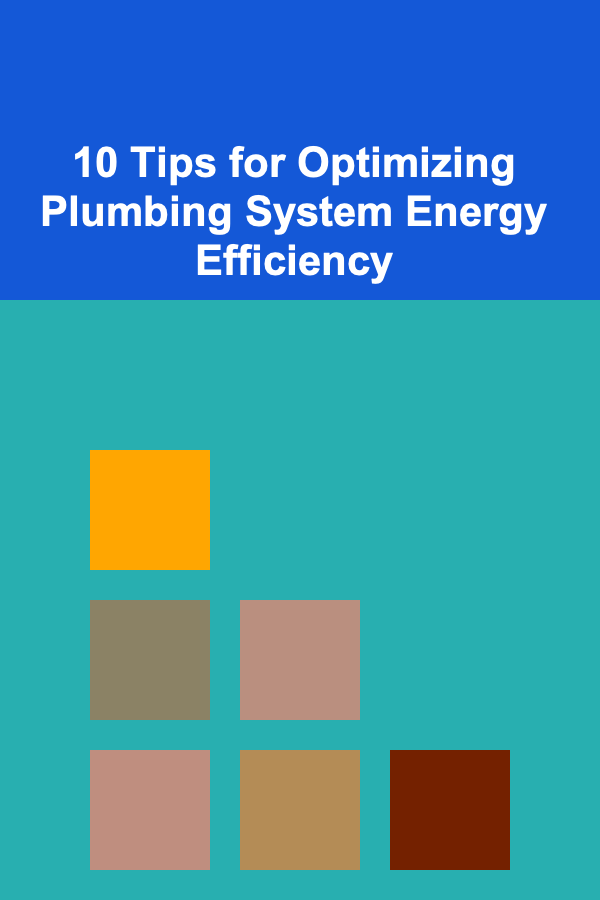
10 Tips for Optimizing Plumbing System Energy Efficiency
ebook include PDF & Audio bundle (Micro Guide)
$12.99$9.99
Limited Time Offer! Order within the next:

In today's world, where sustainability and energy conservation are crucial for both environmental and financial reasons, optimizing the energy efficiency of your home's plumbing system is a smart and responsible approach. Plumbing systems are vital to everyday life, as they provide the necessary infrastructure for water flow, heating, and waste removal. However, these systems can often consume a significant amount of energy, especially when not maintained or optimized effectively.
Optimizing the energy efficiency of your plumbing system can lead to reduced energy bills, a more eco-friendly household, and an overall improved standard of living. In this article, we will delve into 10 actionable tips for improving the energy efficiency of your plumbing system, ensuring that both you and the environment benefit from the changes.
Install Low-Flow Fixtures
One of the most effective ways to optimize the energy efficiency of your plumbing system is by installing low-flow fixtures. These fixtures, which include showerheads, faucets, and toilets, are designed to reduce the amount of water used without sacrificing performance.
Low-flow showerheads, for instance, can reduce water usage by up to 50%, while still maintaining adequate water pressure for an enjoyable shower experience. Low-flow toilets use significantly less water per flush, and low-flow faucets help conserve water in kitchens and bathrooms.
By installing these energy-efficient fixtures, you not only save water but also reduce the amount of energy required to heat it. This is particularly important if you rely on a water heater, as less water needs to be heated, lowering your energy consumption and utility costs.
Upgrade Your Water Heater
The water heater is one of the biggest energy consumers in your home. Depending on the model and its age, it could be wasting energy and driving up your energy bills. To improve the energy efficiency of your plumbing system, consider upgrading to a more energy-efficient water heater.
There are several options available, including:
- Tankless Water Heaters: These heaters provide hot water on demand, eliminating the need for a large storage tank. Since they only heat water when needed, they can be significantly more energy-efficient than traditional tank water heaters.
- Heat Pump Water Heaters: These use electricity to move heat from the air or ground into the water, rather than generating heat directly. As a result, they use much less energy compared to conventional water heaters.
- High-Efficiency Tank Water Heaters: If you prefer a traditional tank system, look for high-efficiency models that use advanced insulation and improved technology to reduce energy consumption.
Upgrading to a more energy-efficient water heater can lead to long-term savings by reducing energy waste.
Insulate Hot Water Pipes
Hot water pipes that run through unheated areas, such as basements or attics, can result in significant energy loss. When hot water travels through these uninsulated pipes, it cools down before it reaches the faucet, requiring more energy to heat the water again.
To optimize energy efficiency, consider insulating your hot water pipes. This will keep the water warmer for longer and reduce the amount of energy required to heat it. Pipe insulation is inexpensive and easy to install, making it one of the most cost-effective ways to improve your plumbing system's energy efficiency.
Maintain Your Water Heater Regularly
Proper maintenance of your water heater can prevent energy waste and extend its lifespan. Sediment buildup, for example, can cause the heater to work harder and use more energy to heat the water. Flushing the tank periodically helps remove any sediment buildup and keeps the system running smoothly.
Additionally, check the thermostat on your water heater and adjust it to an optimal temperature, typically between 120°F (49°C) and 130°F (54°C). If the thermostat is set too high, it will require more energy to maintain the water temperature.
Regular maintenance, including inspecting the heating elements and replacing the anode rod, can go a long way in improving the efficiency of your water heater.
Use a Water Softener
Hard water can cause mineral buildup in pipes, water heaters, and appliances, leading to inefficiency and higher energy consumption. Minerals like calcium and magnesium can form scale inside pipes, which restricts water flow and reduces the effectiveness of water heating.
By installing a water softener, you can prevent this buildup and maintain the efficiency of your plumbing system. A water softener uses ion exchange to remove the minerals from the water, reducing scale buildup and preventing clogs in your pipes and appliances. As a result, your plumbing system will work more efficiently, and your energy consumption will decrease.
Fix Leaky Faucets and Pipes
A dripping faucet or leaking pipe may seem like a minor issue, but over time, these leaks can lead to significant water waste. A single leaky faucet can waste hundreds of gallons of water per year, driving up both your water and energy bills. The wasted water also requires more energy to heat, further contributing to inefficiency.
Fixing leaks promptly is essential for optimizing the energy efficiency of your plumbing system. Regularly inspect your faucets, pipes, and fixtures for signs of leaks, and repair them as soon as possible to avoid water wastage and unnecessary energy consumption.
Install a Timer for Your Water Heater
If your water heater runs 24/7, you may be wasting energy by heating water when it's not needed. Installing a timer on your water heater allows you to control when the unit heats the water, ensuring that it only operates during peak usage times.
For example, you can set the timer to turn on the water heater during the morning and evening hours when you're likely to need hot water for showers and dishes. By doing so, you'll avoid keeping the water heater running all day, which reduces unnecessary energy consumption and lowers your energy bills.
Consider Solar Water Heating
For a more sustainable and energy-efficient solution, you might want to consider installing a solar water heating system. Solar water heaters use solar panels to capture the sun's energy and convert it into heat, which is then used to warm the water in your home.
While the initial installation costs can be high, solar water heating systems are highly energy-efficient and can significantly reduce your reliance on electricity or gas. Over time, the savings on your energy bills can offset the initial investment, making it a worthwhile option for homeowners looking to reduce their carbon footprint.
Seal Gaps Around Plumbing Fixtures
Energy loss doesn't only happen inside your plumbing system; it can also occur around plumbing fixtures and pipes. Gaps and cracks around plumbing fixtures such as toilets, sinks, and bathtubs can allow warm air to escape and cold air to enter, leading to increased heating or cooling costs.
To optimize your plumbing system's energy efficiency, inspect areas around your plumbing fixtures and seal any gaps or cracks with caulk or weatherstripping. This will help maintain a consistent temperature inside your home and prevent energy loss.
Install a Recirculation Pump
If you often wait for hot water to reach your faucet or shower, you may be wasting energy as the water cools while it travels through the pipes. Installing a recirculation pump can eliminate this problem by ensuring that hot water is always readily available at your taps.
A recirculation pump works by keeping hot water circulating in the pipes, so it's immediately available when you turn on the tap. This system helps reduce the amount of water wasted while waiting for it to warm up and can significantly improve the overall energy efficiency of your plumbing system.
Conclusion
Optimizing the energy efficiency of your plumbing system is an important step in reducing your energy consumption, lowering utility bills, and contributing to a more sustainable home. By following the tips outlined in this article---ranging from installing low-flow fixtures to upgrading your water heater and maintaining your pipes---you can make a significant impact on both your home's energy performance and your finances.
Remember that a well-maintained and energy-efficient plumbing system not only improves your quality of life but also benefits the environment. Start implementing these strategies today, and you'll be well on your way to creating a more energy-efficient home.
Reading More From Our Other Websites
- [Organization Tip 101] How to Organize Your Downloads Folder for Quick Access
- [Home Renovating 101] How to Install Energy-Efficient Windows
- [Home Rental Property 101] How to Install and Promote a Home Charging Station to Attract Tenants to Your Rentals
- [Rock Climbing Tip 101] The Science Behind Grip: How to Build Finger Strength Safely
- [Organization Tip 101] How to Create a Checklist for Your Essential Oil Collection
- [Home Renovating 101] How to Renovate Your Swimming Pool for Maximum Enjoyment
- [Personal Investment 101] Build an AI Startup with Deep Learning for Recurring Income
- [Paragliding Tip 101] Breaking Barriers: A Chronology of Record-Setting Paragliding Flights
- [Home Cleaning 101] How to Clean Your Ceiling Fans and Light Fixtures
- [Home Lighting 101] How to Light a Dark Room: Brighten Up Your Space

How to Maintain Your Home's HVAC Filters and Ductwork
Read More
How to Optimize Your Smartphone for Better Organization
Read More
How to Use Dividends to Reinvest and Grow Your Portfolio
Read More
How To Deliver a Persuasive Argument
Read More
How to Become a Savvy Shopper
Read More
10 Tips for Content Strategists to Master Storytelling
Read MoreOther Products

How to Maintain Your Home's HVAC Filters and Ductwork
Read More
How to Optimize Your Smartphone for Better Organization
Read More
How to Use Dividends to Reinvest and Grow Your Portfolio
Read More
How To Deliver a Persuasive Argument
Read More
How to Become a Savvy Shopper
Read More